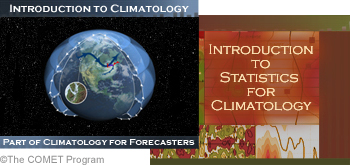About the Module
|
These are the types of questions that Department of Defense (DoD) weather forecasters and other personnel seek answers to from the United States Air Force’s climate division. The division, known as the 14th Weather Squadron (14th WS), is the DoD's largest source of climatological data and analysis products. It receives weather observations on an hourly basis from around the world. These include surface observations of temperature, dew point, wind speed and direction, ceiling and visibility, present weather, precipitation amount, station pressure, and additional remarks.
Many of the requests are so common that the 14th WS has developed a standard suite of climate analysis products. These are increasingly available as customizable products with user-defined variables rather than as preformatted text and graphical products. Most of the products are available online via the NIPRNET (unclassified), SIPRNET (secret), and JWICS (TS-SCI, Top Secret Network). This online system is supported by a team of customer service analysts who handle questions and special requests through the Support Assistance Request (SAR) process.
Module description and intended audience
The module is intended for DoD weather personnel and others interested in learning about the climate data and products available from the 14th WS. The module teaches users how these products can assist them in their jobs and helps them become more informed users. This is especially important in areas of the world with little available weather information, where climatology provides the best, if not only, way of determining likely weather conditions to assist with planning and operations.
While the module may be of interest to non-military users, note that only approved personnel can access the 14th WS website and services. Access to the module on the Air Force Weather Knowledge Center (AFWKC) website is also restricted.
The module presents five scenarios that DoD weather forecasters are likely to encounter and teaches how to handle them using the Climate Analysis Process (CAP). When handling requests that require climate information, CAP helps forecasters hone in on the information needed to obtain the right products and data as quickly as possible.
The module is the third and final one in COMET’s Climatology for Forecasters series. It builds on the preceding modules:

-
Introduction to Climatology, which provides background information on climatology: what it is, the factors that create an area’s climate, and the sources and uses of climate information
-
Introduction to Statistics for Climatology, which explores the basic statistical parameters used in climatology and identifies the statistical parameters that best summarize some weather and climate variables
Data sources
Most of the data and climate products in the module are from the 14th WS. The 14th WS is responsible for the sole content of such materials. No changes have been made to the materials except in sizing and file format.
Since 14th WS web pages and product names change periodically, URLs and, in some cases, product names are not displayed. Instead, the focus is on the types of products and services that are available.
Technical specifications
We recommend a 1024 x 768 (or larger) monitor resolution setting for optimal viewing. If you need to scroll horizontally, your screen resolution is probably not set to those dimensions. However, some pages are long and require vertical scrolling. Maximizing your browser window may reduce the amount of scrolling needed. For the best performance, we also recommend using the current version of your browser.
Note that the module contains text, graphics, animations, and data products. No audio is included.
